#colossosuchus
Explore tagged Tumblr posts
Text
Fossil Crocs of 2023
2023 has been a year with its ups and downs, but one consistent thing has been its fossil crocs at least, giving us another interesting variety of species and genera not known before. Like last year, I'll go down each of them (including phytosaurs) and give you some key notes. And since I've done my best to make individual posts for them I'll link those when available. I'll also try to give translations where possible, but do note that sometimes I might switch around a word due to it just sounding awkward otherwise.
Scolotosuchus
Starting us off is Scolotosuchus basileus ("royal scythian crocodile"), a basal, rauisuchian-like animal from the early stages of the Triassic. An animal roughly 3 meters long, it is primarily known from vertebrae and some other material, which however does have interesting implications. Based on the anatomy of the vertebrae, it has been speculated that Scolotosuchus performed a lot of rapid movement of the neck, presumably while hunting. Furthermore, it might be that Scolotosuchus lacked osteoderms, instead having developed a bracing system for its body much more like that of dinosaurs and mammals. Artwork by @knuppitalism-with-ue (he'll pop up quite a lot)
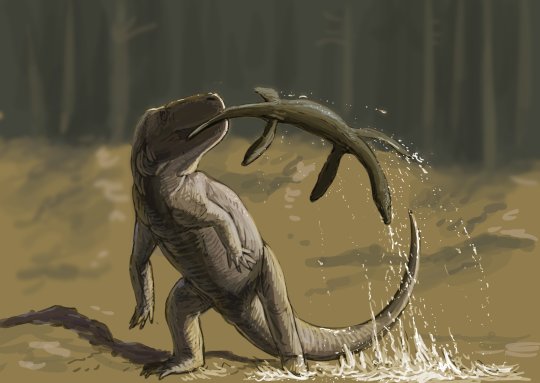
Colossosuchus
Fast forward to the Late Triassic, the hayday of early Pseudosuchians, and we find our first phytosaur of the list. Colossosuchus techniensis ("colossal crocodile of the Indian Institute of Technology") was an enormous animal from India's Tiki Formation. This one is known from undisputably better material, perhaps some of the best on this list as we have an entire bone bed of these guys, possibly representing a mass death site. Size estimates of the large specimens generally range from 6 to 9 meters in length, also making it the largest animal of this list, with the authors favoring an estimated 8 meters for the largest individual. Of course this is all subject to change, as we don't know the precise proportions (the downside of a bone bed is that all the bones are kinda jumbled together and god knows what belongs to what). Artwork by Joschua Knüppe again, a female being courted by an overconfident and confused Volcanosuchus (told you so)

Kryphioparma
Ok I won't bother you with this one too much. Kryphioparma caerula ("blue mysterious shield") is an aetosaur from the Late Triassic Chinle Formation of Arizona. Now aetosaurs are cool of course, but the thing is that Kryphioparma is known from exclusively osteoderms, their large armour plates. While thats valid, its also not really exciting (as you could have guessed from the absolute lack of artwork). Best I can say is that it coexisted with a bunch of other aetosaurs, which surely would have been a sight to see back in the day.
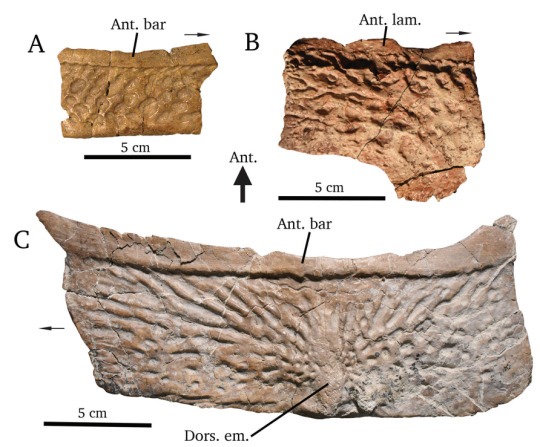
Venkatasuchus
Now Venkatasuchus armatum ("Venkata's armoured crocodile") is in a similar boat. This Indian aetosaur too is only known from osteoderms, tho at least a lot more of them that were found together, meaning we got a much better idea of its shape. There are some interesting implications it has on paleogeography and how different animal groups spread across Pangea, but that's probably beyond the scope of this post. There is at least some art of it tho, including one piece by Joschua featuring Jaklapallisaurus, an early sauropodomorph.
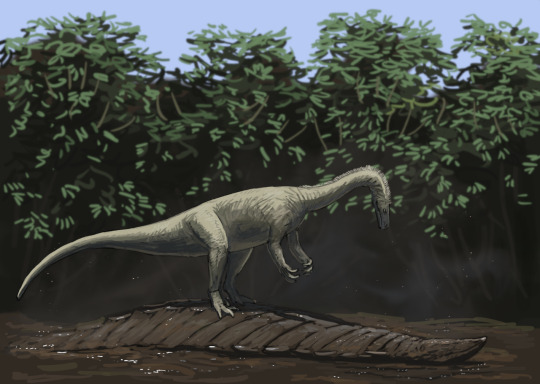
Mystriosuchus alleroq
Now we got our first new species of a preexisting genus. While I did my best to make posts on new genera, which typically went hand in hand with their respective wikipedia pages, species are a different matter since they'd require me to overhaul and research the whole genus. Which for Mystriosuchus would go all the way back to 1896.
Anyhow, Mystriosuchus alleroq ("jawbone spoon crocodile") is the newest in a long line of Mystriosuchus species and has been recovered from western Greenland of all places. Like Colossosuchus it is known from multiple individuals, at least four in fact, And like Venkatasuchus, it appears to have wideraning implications for the spread of archosaurs during the Triassic. Oh look its Josch's art again, neat.
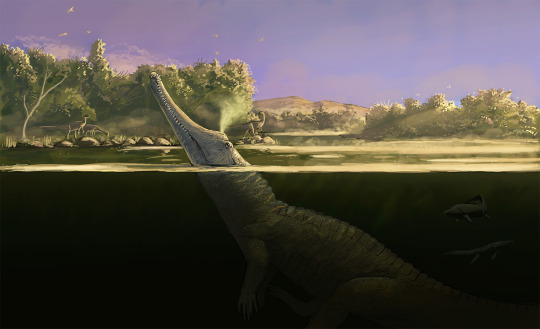
Jupijkam
The final phytosaur and the final Triassic taxon of the year, Jupijkam paleofluvialis ("horned serpent of ancient rivers") was recovered from Nova Scotia Canada and represents one of the northernmost phytosaurs (alongside obviously our friend Mystriosuchus alleroq above). It is far less complete than the other phytosaurs I covered so far, but still nothing to scoff at. It's also one of the youngest known phytosaurs, possibly having lived during the last stage of the Triassic. There's no art but here's an image of its snout from the original paper.

Turnersuchus
And with this we have reached the Jurassic and somewhat of a double feature. Ordering these via chronology makes this almost like storytelling. Turnersuchus hingleyae ("Hingley's and Turner's crocodile") is the oldest and basalmost named thalattosuchian, a group of crocodylomorphs that took to the seas. As such it shows a mosaic of features, already having begun to reduce its limbs, having a moderately long snout and still bearing osteoderms, which some of its descendents would come to lose. Turnersuchus dates to the Pliensbachian, a stage of the early Jurassic, tho the paper mentions how its not likely to hold its title as oldest member of its group for long as even older material has been discovered and is awaiting publication. Artwork by Júlia d’Oliveira and Joschua Knüppe

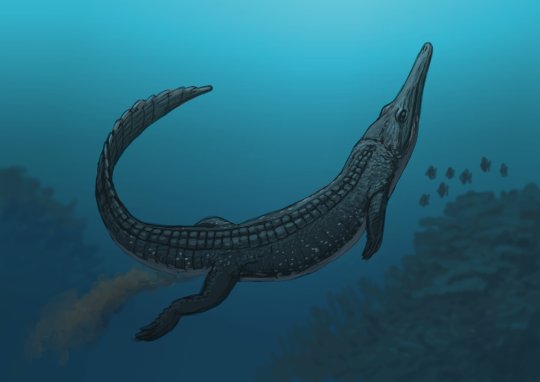
Torvoneustes jurensis
While Turnersuchus gives us a glimpse at what the earliest thalattosuchians were like, Torvoneustes jurensis ("savage swimmer of the Jura Mountains") represents them at one of their most derived. At 4 meters long, it must have been an impressive creature, entirely smooth and lacking osteoderms, highly reduced arms and a tail fluke to boot. There are some interesting features, as unlike other species of Torvoneustes, this one does not appear to have been as durophagous, instead appearing to be more of a generalist. It's the last Jurassic croc of the year and practically lived at the opposite end of this time period relative to our previous thalattosuchian, during the Kimmeridgian. Artwork by Sophie De Sousa Oliveira, not to be confused with Jùlia who drew Turnersuchus.
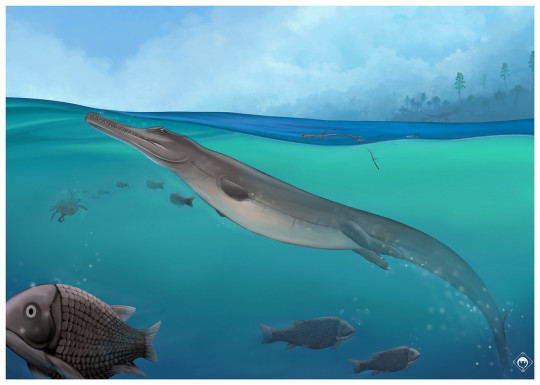
Comahuesuchus bonapartei
From marine to terrestrial, Comahuesuchus bonapartei is a member of the Notosuchia, land-dwelling cousins to the Neosuchia. This new species is known from the Cretaceous of Argentina and was described on the basis of a lower jaw, which differs from the previously described species of Comahuesuchus by the fact that the teeth are situated in individual sockets. Its jaws were short and wide, being described as U-shaped, giving it a somewhat pug-nosed appearance. In case you're wondering why I don't have the translation of the name thats because I can't access Bonaparte's first paper, so all I can say is that the new species is named after famed Argentinian paleontologist Jóse Fernando Bonaparte. Artwork by I mean you probably guessed it, its Josch again.
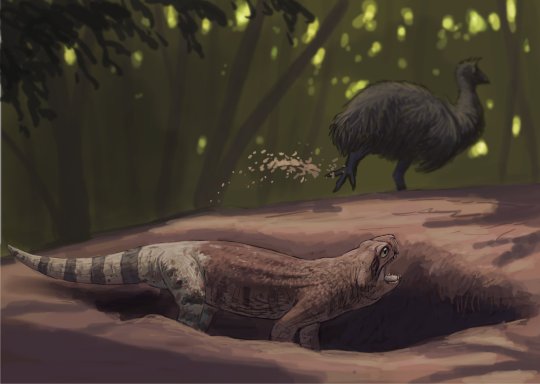
Aphaurosuchus kaiju
I have some mixed feelings on Aphaurosuchus kaiju ("powerless kaiju crocodile"), not just because I have to rewrite its genus wikipedia page that I am no longer happy with. No, Aphaurosuchus is a great genus in my opinion, given the complete nature of the holotype. But I do think that the species name of this second form is a bit of an exaggeration, seeing as it is to my knowledge not that exceptionally big. So why name it kaiju other than to sound cool? I also think it just kinda becoms funny when you consider the meaning of the genus name. Anyhow, it does look pretty mean, but thats to be expected from a baurusuchid. It lived during the Late Cretaceous in Brazil and the phylogenetic analysis that accompanied its description had some interesting implications that I'm curious to see tackled in the future. Other than that it's just another baurusuchid from a place crawling with baurusuchids, which tbh is pretty cool itself but doesn't really help make it stand out. Arwork by Paula Zeinner
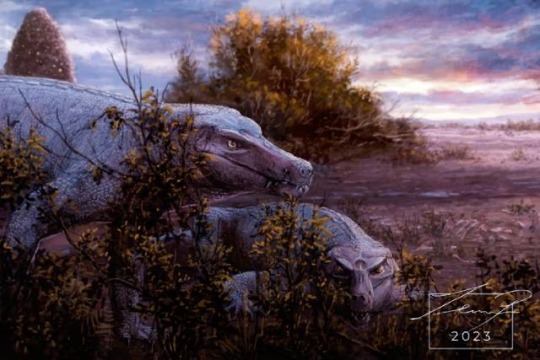
Dentaneosuchus
It is the middle Eocene. France is entirely occupied by mammals. Well, not entirely... One indomitable reptile still holds out against the invaders. Yes, I am of course talking about Dentaneosuchus ("frightfull crocodile"), the titan of the Eocene, the terror of the jungle. Easily among the most exciting finds, this animal was an enormous sebecid previously thought to be a member of the genus Iberosuchus, but recent research not only shows its distinct but enormous. With a lower jaw around 90 cm long, it rivals even the famed Barinasuchus of Miocene South America. The total body lenght is of course a matter of debate given how little we know about sebecid proportions, with the paper lowballing it at 3 to 4 meters and I personally recovering something more akin to 5 meters. Regardless of the specifics, this would make it easily one of the top predators of its time, tho sadly this was not meant to last. It was among the last non-mammalian apex predators of Europe, before climate change and competition from mammals eventually drove them to extinction. Arwork by Joschua Knüppe and @mariolanzas

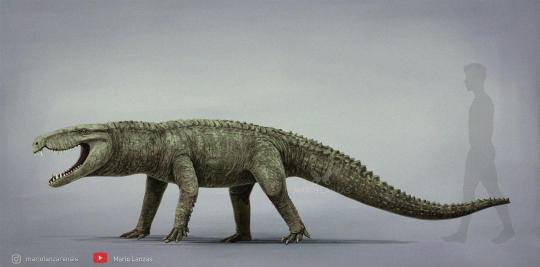
Baru iylwenpeny
Our last three entries were all members of the Notosuchia, the terrestrial crocodiles that existed from the Jurassic to the Miocene, so lets jump to the other major group of the time, the Neosuchians, specifically their most recent branch, the Crocodilians. Yes finally we are getting to crocs in the stricter sense.
Baru iylwenpeny ("divine crocodile thats good at hunting") is an animal we also knew for a while under the informal name Alcoota Baru based on where it was found. This year I spent a lot of time writing in the Mekosuchinae, Australasian crocodiles of the Cenozoic and just when I had finished the page for Baru, this guy got published. It's the largest, most robust and most recent member of the genus. Good at hunting is a good choice for the species name, as this animal was over 4 meters long with a head commonly likened to a cleaver and a hunting style speculated to consist of inflicting a lot of trauma on its prey with its massive teeth. I could gush about Baru for ages, but thats the important parts. It lived in central Australia during the Miocene only 8 million years ago. Artwork by the incredible @manusuchus
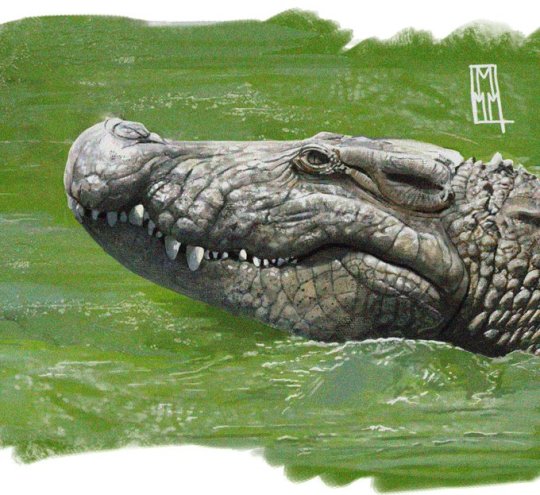
Antecrocodylus
Now for the last crocodilian described this year and one I remised to make a dedicated post for due to time constraints (I had a busy few months). Antecrocodylus chiangmuanensis ("before Crocodylus from Chiang Muan") is a close relative of the modern dwarf and true crocodiles from the Miocene of Thailand. It is only known from the back of the skull and an associated lower jaw, but it serves to highlight how little we know about the crocodiless of eastern Asia during the Miocene, which is a shame given that this region is crucial to deciphering where true crocodiles originated.
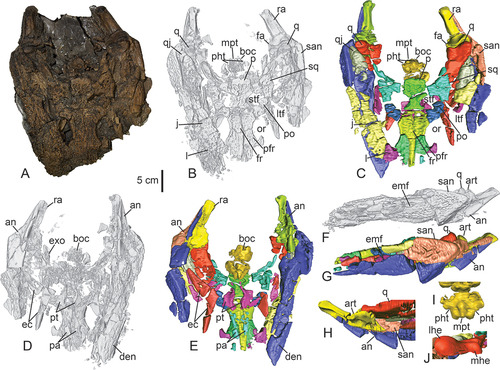
Alligator munensis
And our final taxon is Alligator munensis ("Mun river alligator"), which, obviously, is a member of the modern genus Alligator and thus most closely related to the still extant Chinese and American Alligator. Likely having been split from its Chinese relatives when the Tibetan plateau was lifted up, this species lived during the middle Pleistocene in Thailand and may have survived until the Holocene. It's head was short and robust and its teeth globular, which could indicate that it fed on hard-shelled prey like clams and snails. It was also small, likely not much bigger than 1.5 meters. Artwork by Joschua Knüppe


And that should be all of them, all new species and genera of Pseudosuchians described this past year. It's once again been fun to look back and I hope that you find them just as interesting as I do. Lets hope that 2024 will bring equally fascinating discoveries.
#alligator munensis#alligator#croc#crocodile#pseudosuchia#notosuchia#crocodilia#crocodylus#antecrocodylus#thalattosuchia#torvoneustes#paleontologoy#torvoneustes jurensis#turnersuchus#comahuesuchus#aphaurosuchus#aphaurosuchus kaiju#dentaneosuchus#jupijkam#colossosuchus#palaeoblr#prehistory#kryphioparma#venkatasuchus#mystriosuchus#scolotosuchus#baru#baru iylwenpeny#science
270 notes
·
View notes
Text

Colossosuchus for croctober!
7 notes
·
View notes
Text

Day 1: Colossosuchus
An extinct genus of large mysteriosuchine phytosaur from upper late Triassic of India.
This is a new and differently challenging situation for October. So I have to skipped Inktober so I have to go practice with crocodilians and non-crocodilian archosaur type creatures.
Enjoy while I do sketching, and sketching is fun.
25 notes
·
View notes
Text

Croctober first day:
Colossosuchus
Using prompt by @/arminreindl :

11 notes
·
View notes
Text




Results from the #paleostream!
Concavispina, Colossosuchus (and a horny Volcanosuchus), Chucarosaurus (with dead rebbachisaur) and Gobipteryx.
#paleoart#sciart#sauropod#dinosaur#phytosaur#bird#colossosuchus#thallatosaur#india#gobipteryx#triassic#marine#cretaceous#palaeoblr#paleostream
728 notes
·
View notes
Text

Colossosuchus
Colossosuchus — вимерлий рід великих містріозухінських фітозаврів з верхньотріасової формації Тікі в Індії. Це був один з найбільших відомих фітозаврів, що сягав у довжину понад 8 м. Серед його характерних рис — куполоподібна голова і загнутий вниз кінчик верхньої щелепи. Colossosuchus був частиною ендемічної популяції фітозаврів з Індії.
Повний текст на сайті "Вимерлий світ":
https://extinctworld.in.ua/colossosuchus/
#colossosuchus#india#triassic#phytosauria#reptiles#paleontology#paleoart#prehistoric#art#animal art#ua#digital art#illustration#animals#fossils#палеоарт#палеонтологія#ukraine#ukrainian#article#science#наука#тварини#україна#мова#українська мова#арт#український пост#українцівтамблері#creatures
7 notes
·
View notes
Text
Fossili di fitosauro gigante rinvenuti in India
Ricostruzione in vita di una specie di fitosauro chiamata Protome batalaria. I paleontologi dell’Indian Institute of Technology hanno descritto un nuovo sorprendente genere e specie di rettile simile a un coccodrillo grazie ai fossili rinvenuti in India. Il Colossosuchus techniensis si aggirava sul nostro pianeta durante il Triassico superiore, tra 235 e 208 milioni di anni fa. L’antico…

View On WordPress
0 notes
Text

I'm bringing back the Croctober Art Challenge.
I last did one waaay back in 2022 before I had Tumblr and I thought I'd give it another shot, both for myself and for other people to join.
I made sure to select a diverse selection of pseudosuchians, from the Triassic to the Pleistocene, with plenty of breaks over the weekends and some non-taxon based prompts as well.
Here again the full list
Colossosuchus
Desmatosuchus
Camouflage
Parvosuchus
Break
Break
Ancient Rivals
Lotosaurus
Postosuchus
Junggarsuchus
Injury
Break
Break
Indosinosuchus
Enalioetes
Parental Care
Hamadasuchus
Caipirisuchus
Break
Break
Dentaneosuchus
Terminonaris
KPG Extinction
Anthracosuchus
Asiatosuchus
Break
Break
Boverisuchus
Travel
Baru
Euthecodon
Hope to see people join this one, I'll try to keep up with my own list as well.
#croctober#croctoberart#croctober art challenge#croctoberart24#pseudosuchia#art challenge#october#prompt list
48 notes
·
View notes
Text

So a couple of days ago a new phytosaur was published by Datta and Ray from India's Tiki Formation. For those unaware, Phytosaurs are large, superficially croc-like reptiles that lived in freshwater throughout much of the Triassic. They can easily be separated from crocs by the fact that their nose is on top of the head. But I digress. So Datta and Ray described Colossosuchus based on over 300 remains from a bonebed, containing everything from young animals less than 5 meters long to absolute giants.
The paper included the composite skeletal you see above, which I scaled here compared to Steve Irwin, which already yields an impressive animal. HOWEVER this skeleton wasn't scaled to the biggest known material, a lower jaw 1.1 meters long. So I did that and....

that gives us THIS ABSOLUTE MONSTER. Over 8 meters long (the tail tip is missing in the image above) and easily one of the biggest phytosaurs we know off. Of course thats assuming that these are the correct propotions seeing as its a combination of multiple individuals of a single bonebed. I can't say much since phytosaurs aren't my speciality, but as far as the claims of the papers go thats what they suggest.
Whats also fun is that this is not the only phytosaur from the Tiki Formation. In 2019 the same authors described Volcanosuchus, a smaller phytosaur but no less interesting. Here you see a reconstruction of Volcanosuchus compared to a reconstruction of Colossosuchus.


Then obviously the next question I had was "How big would they be next to each other?" So I scaled the skull of Volcanosuchus (scalebar is 5 cm) to the largest individual Colossosuchus (with the reconstructed skull superimposed) and well its not even close.

I really gotta look more into phytosaurs at some point, since I know a lot less about them than I'd like to. So that could be an interesting research journey in the future. Also might make a proper size chart based on these for Wikipedia eventually if I find the motivation.
#Colossosuchus#phytosauria#volcanosuchus#not crocodiles#triassic#india#steve irwin for scale#giant reptile#paleontology#prehistory#palaeblr
62 notes
·
View notes